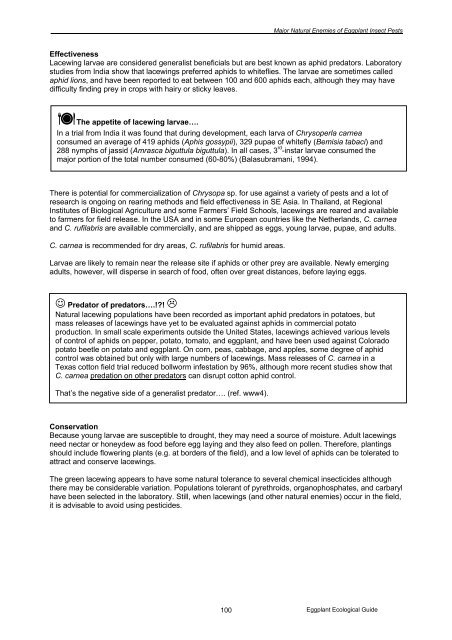Eggplant Integrated Pest Management AN ECOLOGICAL GUIDE
Eggplant Integrated Pest Management AN ECOLOGICAL GUIDE
Eggplant Integrated Pest Management AN ECOLOGICAL GUIDE
You also want an ePaper? Increase the reach of your titles
YUMPU automatically turns print PDFs into web optimized ePapers that Google loves.
__________________________________________________________________Major Natural Enemies of <strong>Eggplant</strong> Insect <strong>Pest</strong>sEffectivenessLacewing larvae are considered generalist beneficials but are best known as aphid predators. Laboratorystudies from India show that lacewings preferred aphids to whiteflies. The larvae are sometimes calledaphid lions, and have been reported to eat between 100 and 600 aphids each, although they may havedifficulty finding prey in crops with hairy or sticky leaves.The appetite of lacewing larvae….In a trial from India it was found that during development, each larva of Chrysoperla carneaconsumed an average of 419 aphids (Aphis gossypii), 329 pupae of whitefly (Bemisia tabaci) and288 nymphs of jassid (Amrasca biguttula biguttula). In all cases, 3 rd -instar larvae consumed themajor portion of the total number consumed (60-80%) (Balasubramani, 1994).There is potential for commercialization of Chrysopa sp. for use against a variety of pests and a lot ofresearch is ongoing on rearing methods and field effectiveness in SE Asia. In Thailand, at RegionalInstitutes of Biological Agriculture and some Farmers’ Field Schools, lacewings are reared and availableto farmers for field release. In the USA and in some European countries like the Netherlands, C. carneaand C. rufilabris are available commercially, and are shipped as eggs, young larvae, pupae, and adults.C. carnea is recommended for dry areas, C. rufilabris for humid areas.Larvae are likely to remain near the release site if aphids or other prey are available. Newly emergingadults, however, will disperse in search of food, often over great distances, before laying eggs.☺ Predator of predators….!?! Natural lacewing populations have been recorded as important aphid predators in potatoes, butmass releases of lacewings have yet to be evaluated against aphids in commercial potatoproduction. In small scale experiments outside the United States, lacewings achieved various levelsof control of aphids on pepper, potato, tomato, and eggplant, and have been used against Coloradopotato beetle on potato and eggplant. On corn, peas, cabbage, and apples, some degree of aphidcontrol was obtained but only with large numbers of lacewings. Mass releases of C. carnea in aTexas cotton field trial reduced bollworm infestation by 96%, although more recent studies show thatC. carnea predation on other predators can disrupt cotton aphid control.That’s the negative side of a generalist predator…. (ref. www4).ConservationBecause young larvae are susceptible to drought, they may need a source of moisture. Adult lacewingsneed nectar or honeydew as food before egg laying and they also feed on pollen. Therefore, plantingsshould include flowering plants (e.g. at borders of the field), and a low level of aphids can be tolerated toattract and conserve lacewings.The green lacewing appears to have some natural tolerance to several chemical insecticides althoughthere may be considerable variation. Populations tolerant of pyrethroids, organophosphates, and carbarylhave been selected in the laboratory. Still, when lacewings (and other natural enemies) occur in the field,it is advisable to avoid using pesticides.100<strong>Eggplant</strong> Ecological Guide




![Section 4 [ PDF file, 252 KB] - The Field Alliance](https://img.yumpu.com/51387260/1/158x260/section-4-pdf-file-252-kb-the-field-alliance.jpg?quality=85)











